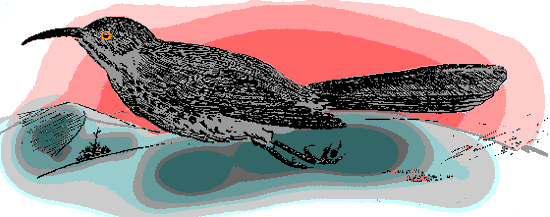Adapted from Jim Conrad's online book A Birding Trip through Mexico, This excerpt from "The Dunes of Samayaluca" northern Chihuahua state

"HEY, YOU!"
With dune crests blazing, I walk along chilly, blue-shaded dune slopes. With immense satisfaction, before having even crossed the first dune, the desert's silence is shattered by a piercing, almost startling whit-wheet, enunciated like the "Hey, you!" whistle some people use to get attention. The call comes from a car-size thicket of yuccas atop a sand ridge connecting two nearby dune peaks.
Despite my slow approach to the yuccas, the whit-wheeter spooks and escapes to the crest of the next dune, landing starkly silhouetted against the glaring eastern sky, fairly galloping onto the ridge, kicking up a silhouetted spray of sand atop the silhouetted dune.
The running silhouette displays an eleven-inch long (28 cm) songbird with a curved bill and a longer-than-usual tail. Anyone familiar with American birds would know that it's a kind of thrasher. Circling the dune for a look at the bird's sunny side, I'm ready to say which thrasher it is after catching a glimpse of nothing more than its eye color, for it's the only thrasher in this part of Mexico with reddish-orange eyes, the Curve-billed Thrasher.
Except for its orange eyes it's a drab bird, the dark, dingy hue of a rag that's been used to wipe off a very dirty car. Filthy House Sparrows in sooty Third-World cities are this color. Indistinct streaks on the bird's chest show like curdles formed atop sour milk.
This dramatic appearance pleases me greatly. Even though the species is common in this region wherever sparse desert scrub occurs, I would never have seen it when I first started birding as a farmboy in Kentucky. The closest Curve-billed Thrashers come to my childhood home is central Texas, some 700 miles (1,100 kms) southwest of Kentucky.
This is something I've always done -- related plants and animals seen during my travels to the species I knew so intimately as a kid. In a way, the degree to which I always "feel at home" varies in direction proportion to how many plants and animals around me are the same I knew as a kid. When I see something like this Curve-billed Thrasher, I am thrilled by its exoticness.
Now, with an immense sense of satisfaction, I bring out my notebook and write:
October 5 latitude 31º21'N, longitude 106º27'W
MEXICO: Chihuahua; ±10 km NE of town of Samalayuca, elev. ±1,300 m (±4,300 feet); sand dunes with some sparse herbs, grasses and low shrubs in dune troughs, a few yuccas on dune slopes
- Curve-billed Thrasher